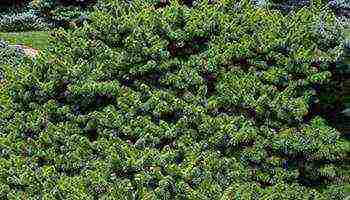Content
- 0.1 Decorative varieties
- 0.1.1 ‘Glauka Globoza’, Glauca Globosa ’,‘ Glauca Globosa ’.
- 0.1.2 ‘Hopsey’ - ‘Hoopsii’.
- 0.1.3 ‘Montgomery’ - ‘Montgomery’.
- 0.1.4 Barbed spruce ‘Mrs. Cesarini '
- 0.1.5 Colorado spruce 'Lucky Strike'
- 0.1.6 Colorado spruce 'Nidiformis Kalous'
- 0.1.7 Colorado spruce 'Oldenburg'
- 0.1.8 Colorado spruce 'Blaukissen'
- 0.1.9 Colorado spruce 'Blue Trinket'
- 0.1.10 Colorado spruce 'Brynek'
- 0.1.11 Colorado spruce 'Christmas Blue'
- 0.1.12 Colorado spruce 'Edith'
- 0.1.13 Colorado spruce 'Fat Albert'
- 0.1.14 Colorado spruce 'Filip's Blue Compact'
- 0.1.15 Colorado spruce 'Frieda'
- 0.1.16 Colorado spruce 'Hermann Naue'
- 0.1.17 Colorado spruce 'Glauca Pendula'
- 0.1.18 Colorado spruce 'Glauca Procumbens'
- 0.1.19 Colorado spruce "Fastigiata" and its variety "Isel Fastigiata"
- 0.1.20 Colorado spruce "Koster"
- 0.2 New variety of blue spruce Plcea pungens 'Blue Dlamant'
- 1 general information
- 2 Varieties of blue spruce
- 3 We plant and care for blue spruce
- 4 We plant with seeds
- 5 Planting cuttings
- 6 We plant seedlings
- 7 Watering blue firs
- 8 Fertilizing the soil
- 9 We carry out pruning of fir trees
- 10 Preparing blue spruce for winter

Spruce prickly (Picea pungens) is undoubtedly the most famous and probably favorite plant for every gardener. A common synonym for prickly spruce is blue spruce, although not all specimens of this species have blue needles. Amazingly beautiful silhouettes of these firs adorn central parks and streets, as well as significant areas of city buildings. For these beauties, they did not spare space and were planted in small summer cottages of six acres, wishing to see a "New Year tree" in their yard, which later occupied half of the territory. At the end of the XX century. prickly spruce has become a symbol of success and prosperity.
Therefore, today many owners of large plots are striving to plant blue spruces as much as possible. Love for them, of course, deserved, this is a very effective and rather problem-free plant.
One of the advantages This spruce is highly resistant to dust and gas, which is why it grows well on busy highways, where all other conifers do not survive. Blue spruces are not as badly damaged by pests as, for example, pines. And they get sick much less often than the same common spruce, especially with proper planting and care.
The natural habitat of blue spruce is in western North America and extends from southeast Idaho south through Utah and Colorado to Arizona and New Mexico. It grows most often in mountain valleys at an altitude of about 2000-3000 m, located along rivers and streams, on moist soil.
The tree is very tall, grows up to 35-40 m and reaches the age of 600-800 years, especially if it is in its homeland. It grows best on loamy or sandy loam, sufficiently fertile soil. Despite the fact that prickly spruce is quite shade-tolerant, trees grown in the shade look less decorative due to the loss of brightness of the needles and large distances between whorls of branches. It grows slowly at a young age, and after 10 years, the growth rate increases significantly. The plant tolerates cutting and crown molding very well, which makes the spruce more lush. Like any species popular in landscaping, prickly spruce has many forms that differ in height, crown structure, length of needles, and its intensity.
coloring and other indicators. We will briefly dwell on the most common ornamental varieties and, of course, touch upon the possible problems of growing them.
Decorative varieties
The most widely used form in landscaping is 'Glauca'... Almost all tall non-selective trees with a blue tint of needles go under this name. The crown is beautiful, symmetrical, conical. Spruce grows up to 15-20 m in height and usually has more than 30 cm of growth per year. The needles on the branches last for more than 3-5 years. Propagated by both seeds and cuttings. Form very resistant to urban conditions. Possesses high winter hardiness and frost resistance.It is better to plant in large areas, as in small areas the spruce looks cumbersome.
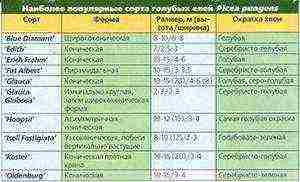
Click to enlarge!
‘Glauca Globoza’, Glauca Globosa ’,‘ Glauca Globosa ’.
It is very widely used in landscaping and is loved by landscape designers, land owners.
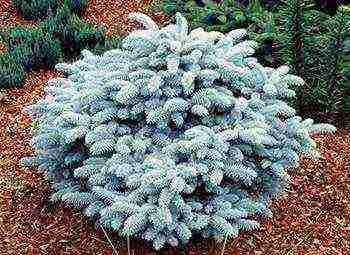
Compact, neat, blue dwarf form of prickly spruce, which usually grows up to 1 m in height and up to 1.5 m in diameter. It looks very decorative both when growing a specimen, and in a group with other plants. The ‘Glauka Globoza’ looks original, grafted onto boles of different heights.
‘Hopsey’ - ‘Hoopsii’.
One of the most beautiful and bluest forms of the prickly spruce. The amazing silver-blue color is preserved and does not fade even in winter.
Despite the high cost of this form, compared to the 'Glauca' form, the 'Hoopsii' spruce is in high demand, which is due not only to the beauty of this form, longer needles, but also more moderate growth.
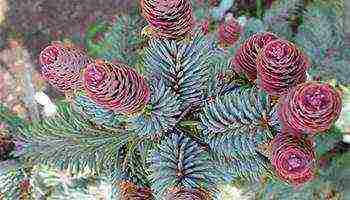
‘Halsey’ grows more slowly and is more commonly used in the field as a Christmas tree. At the age of more than 20 years, it grows up to 8-10 m in height. In young years, so that the curvature of the spruce trunk does not occur, it is worth aligning it with a stick that fixes the top of the plant.
‘Montgomery’ - ‘Montgomery’.
A dwarf, slow-growing form of prickly spruce, the growth of which is no more than 5-6 cm per year. Even after 30 years, the height of this shape and diameter
crown - 1.8 m. The needles are very beautiful, silvery-blue, up to 20 mm in length, they remain on the branches for a long time. Excellent spruce for landscaping.
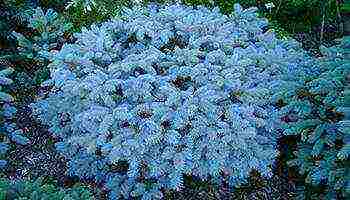
Colorado spruce 'Montgomery'
For planting on site as a Christmas tree, I would recommend ‘Fat Albert’, with a dense, conical crown, but not growing more than 3-4 m in height.
It is interesting on the site that dwarf forms look that can be planted in rockeries, compose a composition with other conifers, these are such relatively recently bred forms as ‘Mrs. Cesarini ' (1981, USA), ‘Lucky Strike’ (1983, Holland), etc.
Barbed spruce ‘Mrs. Cesarini '
Dwarf. Annual growth is about 2.5 cm. It grows slightly over 1 m in height. The crown is cushion-shaped, very dense, irregular in shape. The branches are short and dense. The needles are bluish-green, light green on young shoots. Witch's broom.
Colorado spruce 'Lucky Strike'
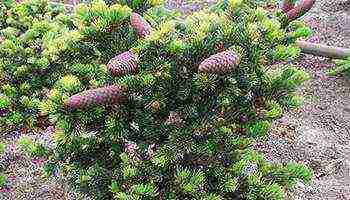
Dwarf. At 10 years old, height 1.2 m, width 0.8 m. The crown is vertical, dense, irregular. The branches are very short and dense. The needles are dense, short, green. Bears abundantly. Young cones are red, protruding, then brownish, drooping.
Colorado spruce 'Nidiformis Kalous'
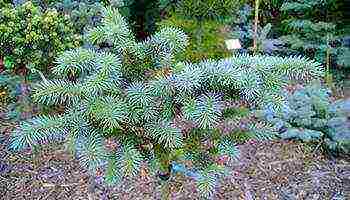
Dwarf. The central leader is poorly developed. The branches are open. The needles are blue. Can be grafted onto a stem.
Colorado spruce 'Oldenburg'
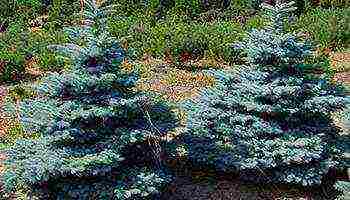
Medium-sized tree, powerful. Annual growth is 10-15 cm. It grows up to 10 m in height. The crown is dense, broadly conical. The needles are bluish-gray.
Colorado spruce 'Blaukissen'
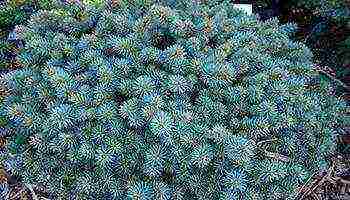
Dwarf form. Annual growth of about 2.5 cm. Dimensions at 10 years: 90 cm high and 1.8 m wide. The crown is oval, very dense, even. The branches are short and dense. The needles are blue, especially on young shoots.
Colorado spruce 'Blue Trinket'

Low tree. The crown is compact, shirokokonicheskaya. The branches are horizontal, arranged in regular tiers. The needles are short, hard, grayish-blue, matte.
Colorado spruce 'Brynek'
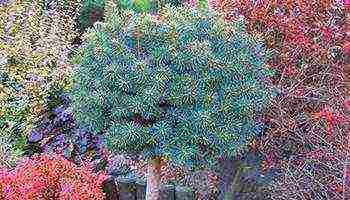
Miniature variety. The crown is dense, hemispherical, flattened. The needles are grayish-green. Witch's broom. It is grafted onto the stem.
Colorado spruce 'Christmas Blue'
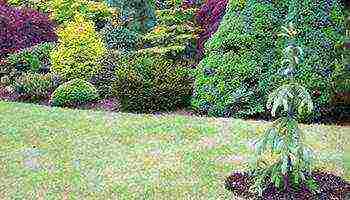
Medium tree. The crown is very regular, conical. The needles are silver-blue.
Colorado spruce 'Edith'
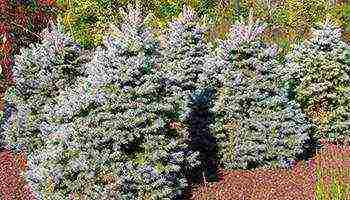
Medium height. At 10 years old, the height is about 2 m. The crown is pyramidal, rather flat. The needles are thin, short, silvery-blue. Good alternative to 'Hoopsii'.
Colorado spruce 'Fat Albert'
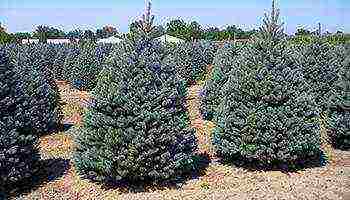
The crown is pyramidal, even. Height 3-4.5 m. The needles are bright blue when blooming, then green, less than 1 cm long.
Colorado spruce 'Filip's Blue Compact'
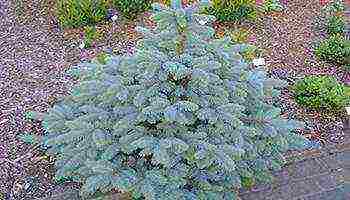
Dwarf. Very beautiful. The crown is wide-pyramidal, dense and even. The needles are blue.
Colorado spruce 'Frieda'
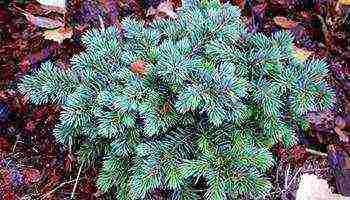
Dwarf. At 10 years old, the height is 1.2 m, the width is 0.6 m. The crown is round, irregular, very dense. The needles are bluish-green. Witch's broom.
Colorado spruce 'Hermann Naue'
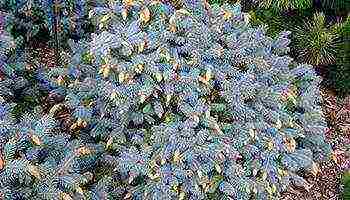
Dwarf. At 10 years old it reaches 0.5 m in height and 0.7 m in diameter. The crown is cushion-shaped, of indefinite shape. There is no central leader.The branches are short, variously directed. The needles are grayish-blue. Fruiting at an early age, the numerous cones at the ends of the branches look very impressive. A similar 'Early Cones' variety that grows much more slowly.
When landscaping a site, you should also pay attention to spruce with an unusual crown shape, such as 'Glauca Pendula', 'Glauca Procumbens'... Forms with a narrow pyramidal crown and branches pointing upward began to enjoy well-deserved attention: ‘Fastigiata’ Clseli Fastigiata), as well as ‘IseliFoxtail’(1965, USA) and 'Blue Totem'.
Colorado spruce 'Glauca Pendula'
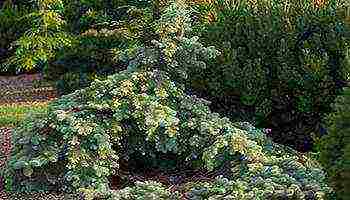
The central leader is weak, crooked, can droop with the top. Skeletal branches hanging with raised ends. Hanging twigs. The needles are silver-blue.
Colorado spruce 'Glauca Procumbens'
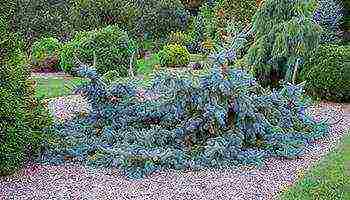
Dwarf, prostrate. There is no central leader, it can be replaced by side branches. Skeletal branches are long, outstretched, with rising ends, like swirling waves. Hanging twigs. The needles are gray. Sport by ‘Koster’. To preserve the creeping shape, it is necessary to remove the vertical shoots.
Colorado spruce 'Glauca Prostrata'
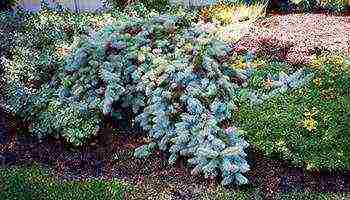
It grows slowly. Crohn's indefinite shape. Usually it is spread, the branches are creeping and raised above the ground. Old type specimen (Germany), however, has a vertical stem 6 m high. A creeping variety that rarely produces vertical shoots is 'Gotelli Prostrate'.
Colorado spruce "Fastigiata" and its variety "Isel Fastigiata"
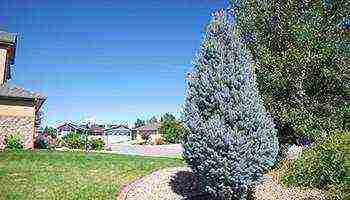
Colorado spruce "Fastigiata" was bred in the 60s of the last century in the USA. In height, trees of this variety reach the same height as wild-form trees. Spruce prickly "Isabeli Fastigiata" (‘Iseli Fastigiata’) has a narrow pyramidal crown with oblique branches. The upper branches are almost pressed against the trunk; characteristic long apical shoots extend from them. The needles are bluish-green. Other narrow varieties are ‘Iseli Foxtail’ (1965, USA) and ‘Blue Totem’.
Colorado spruce "Koster"
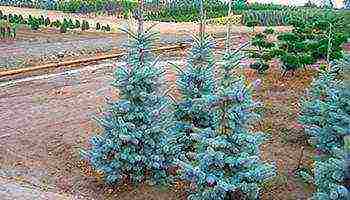
‘Koster’(until 1885, Holland). Glauca Group. Colorado spruce "Koster" is a tree with a neat pyramidal crown. Branches are whorled, strictly horizontal. The needles are 2025 mm long, silvery, protecting the color in winter. Originally genetically heterogeneous material served as the basis for the Koster variety.
Thus, now on the market there are many interesting decorative forms of prickly spruce, but, having planted them on the site, do not forget that, like any plant, they can suffer from under-watering or soaking roots, bad soils, deepening of the root collar during planting, as well as exposure to diseases and pests.
New variety of blue spruce Plcea pungens 'Blue Dlamant'
This variety, like most varieties of prickly spruce, was bred in America in 1990, and more recently appeared in European and in our nurseries.
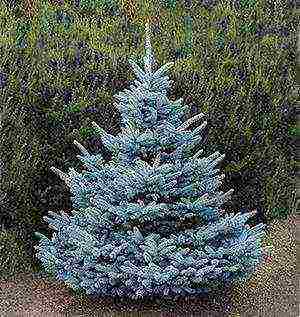
The variety is distinguished by very thin, delicate needles of a sky-blue color, an even wide-conical shape and slow growth. During the year, the plant grows only 10 cm in height, a 10-year-old plant is 1 meter high and 0.6-0.8 m wide, so adult plants are very expensive.
An adult plant reaches a height of 5-7 m. The branches form regular dense tiers around the trunk from the ground to the very top, the plant is very dense and fluffy, has a natural beautiful shape and does not need special molding.
Prefers a sunny location, drained and slightly acidic soil.
Blue spruce - varieties
An excellent choice of decorative beautification of the garden plot is the planting of a blue spruce. There are many varieties of this coniferous tree and every gardener can easily pick up a tree for his taste and needs.
general information

The original place of growth of blue spruce is considered to be North America.
North America is considered the original place of growth of blue spruce. In nature, the place where this tree grows is in the highlands, which is why it is well adapted to low temperatures and gusty winds. In Russia, this type of tree is widely used as a decorative one.
The blue spruce gained popularity not only due to its beauty, but also by its unpretentious care.
The main difficulty arises only at the very beginning of the growth of the tree. Further, it practically does not require human intervention. The key to good growth is a competent determination of the landing site.Almost all varieties of blue spruce do not like shady areas, some like loose soil, and several varieties can grow even in rocky areas.
Varieties of blue spruce
Over the years of selection, many varieties of this tree have been obtained. For your suburban area, you can choose a tall spreading tree or a low compact tree. Particularly popular with Russian gardeners are:
Blue diamond
This variety is characterized by a conical crown and a long trunk. It grows slowly, about 15 centimeters per year. Mature trees reach seven meters.
Walburn
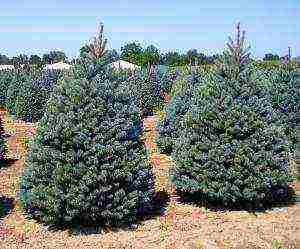
There are many varieties of blue spruce
Low spruce trees with good frost resistance. Most often they are planted in stone gardens. The shape of the crown is spherical with a diameter of up to one meter.
Biolobok
The maximum height of this variety of blue spruce is two meters. The crown grows unevenly, the branches are short and tough. In young trees, the shoots have a golden color, which landscape designers love to use.
Iseli Fastigiata
The branches of this variety stretch upward forming a pyramidal crown shape. They reach a height of ten meters. This variety is able to tolerate droughts, but is painful in wetlands. It is used in single planting and as a hedge.
Montgomery
The peculiarity of the variety is the cushion-shaped crown, which takes the form of a cone over time. Trees grow no more than two meters high and grow extremely slowly. The younger the tree, the lighter the needles.
In seedlings, the color is closer to silver than blue. This variety is very susceptible to care and, without proper handling, quickly loses its decorative effect.
Glauka Misty Blue
The crown has a regular conical shape with neat tiers of branches. The trees are tall, reaching twenty meters in height.
Aurea
The main feature of this variety is the golden color of the needles of young trees. The crown is thick. The branches grow horizontally and in large numbers. A frost-resistant variety that loves bright sun.
Bonfire
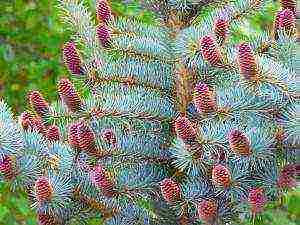
There is a Dutch variety of blue spruce
A Dutch variety of blue spruce with a pyramidal crown shape. This variety is expensive. It grows slowly, but reaches ten meters in height. The girth of the crown of an adult tree reaches 3-4 meters.
Fat Albert
Trees of this variety have a conical crown and reach four meters in height. The growth is fast. It can be planted both separately and as part of a group of trees. Loves the sun and does not tolerate swampy soil.
Hoopsie
Suitable for growing exclusively in the garden. The branches of the tree are evenly spaced and form a beautiful crown. The crown width of an adult tree reaches four meters. The tree grows relatively quickly, adding 10-20 centimeters per year.
Blue totem
The trees grow up to 4-5 meters in height. The crowns reach one meter in diameter and have a conical shape with branches tightly fitting to the trunk. A frost-resistant variety that loves sun and moist soils.
Blue pearl
Belongs to the class of dwarf spruces. It grows extremely slowly and reaches a maximum of 1.5 meters in height. It has a spherical shape, which can become conical with age. This variety is unpretentious to watering and can grow in clayey areas.
Blue keychain
The trees have a compact, conical crown. The height of mature spruces reaches 7-8 meters. The branches are arranged in regular tiers and form a crown from the very base. Unpretentious to growing conditions, but feels best in damp sunny areas.
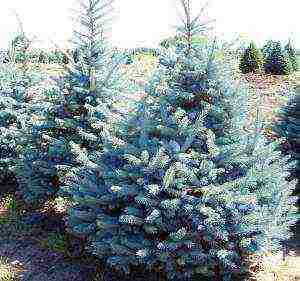
Many of the species have a beautiful crown.
Blue Wonder
Belongs to the class of Canadian blue spruces. Each year the tree grows 10 centimeters and reaches a maximum growth of 2 meters. The crown of the tree is lush and soft, forming a cone. Loves the sun's rays, but is prone to spring sunburn.
Bismarck
A tree with a straight trunk and a conical crown.It belongs to the dwarf class and reaches a maximum height of half a meter. Good frost resistance and drought tolerance. Propagated mainly by seeds and cuttings.
Moerheimi
Strong growing tree with narrow conical shape. Differs in uneven growth, per year the tree adds 10-15 centimeters and reaches a maximum height of ten meters. The color of the needles is the same all year round. The needles are 30mm long and are attached to each other.
The branches are short and grow horizontally. It is preferable to plant this variety in fertile soils. Excess, as well as lack of moisture, has a bad effect on the growth of the tree. It can grow in the shade, but the sun has a positive effect on the overall dynamics and appearance of the tree. Frost resistant. However, at an early age, it requires increased attention and care.
When choosing a tree, in addition to height, it is customary to pay attention to the shape. The classic pyramidal shape looks very aesthetically pleasing and beautiful.
We plant and care for blue spruce
You can start growing a spruce on your own plot in several ways:
- Plant seeds;
- Plant cuttings;
- Use seedlings.
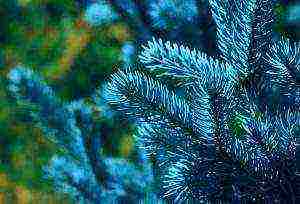
There are three ways to start growing spruce on your own plot
With any method, it will not be difficult to grow a beautiful tree, but you still need to adhere to a certain order of actions.
We plant with seeds
Seeds should be collected from the cones of the variety of interest in the winter. Next, you need to store the collected cones in a warm place until they open. When the bump opens, remove the seeds, dig in the wet sand and leave in the refrigerator until spring. When planting time comes, treat the seeds with a potassium permanganate solution and plant in soil from a mixture of peat and garden soil. It is necessary to deepen the seeds by no more than 1-2 cm. Further, until the moment of germination, it is necessary to water the soil abundantly.
Dig holes at a distance of about 30 centimeters from each other on the site and lay drainage on the bottom. The next time you need to transplant the spruce in the third year of growth and plant them at a distance of one meter.
Planting cuttings
The method of growing a new tree from a branch of a favorite variety is considered even easier than growing by seeds. Branches of adult fir trees collected from the top in springtime are suitable. Remove the needles from the stem and soak in a manganese solution. Further, the procedure is similar to planting seeds: a hole is dug, drainage is laid. Sprinkle the twig with soil first, and add sand on top.
Water liberally and cover the cutting with plastic wrap or burlap. To speed up growth, water the cutting four times a day. For winter, arrange the cutting with sawdust.
We plant seedlings
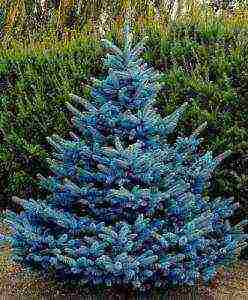
At the time of transplanting a seedling from a pot into open soil, you should pay attention to the location of the root collar
This planting method can be used with any varieties of blue spruce. It is in this way that it is possible to obtain a luxurious tree as soon as possible.
At the time of transplanting a seedling from a pot into open soil, you should pay attention to the location of the root collar. It should stay at the same level as in the pot. Although blue spruces love the sun, it is advisable to keep the seedlings in the shade for the first time after planting.
Watering blue firs
Initial care takes effort and time. It is necessary to water the plant every day and spray the crown of the tree regularly.
Blue ate moisture-loving plants that love abundant watering at least twice a day. In the morning and in the evening. It is necessary to irrigate by sprinkling. When planting spruce on the lawn, you can combine watering cycles. Use only warm water.
Fertilizing the soil
It is highly discouraged to take organic matter as a fertilizer. They also ate negatively about an excess of fertilizing. If you fertilize your spruce abundantly in the summer, it is at greater risk of freezing in the winter. During the first five years, the trees are fed with mineral fertilizers.
One of the proven fertilizers is Kemira Universal.
It is necessary to start the fertilization process immediately after the snow melts. You fill up the fertilizer in the trunk circle and lightly tamp it into the ground. Trees older than five years do not need fertilization.
We carry out pruning of spruce
In the Russian climatic zone, spruce crowns are usually neat and symmetrical in themselves. The pruning procedure is still carried out - diseased and broken branches are removed.
When a hedge is formed from spruce trees, the crown of the trees is formed. Pruning is done in the summer after the growth of the shoots has ended. The initial pruning is done almost immediately after planting.
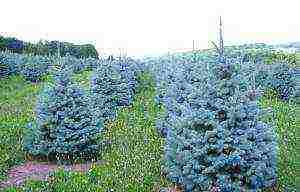
Crown formation is possible during the first seven years
The formation of the crown is possible during the first seven years, then this process will be inappropriate. Do not prune trees in the fall; this may freeze the pruned branches.
Also, it is not necessary to treat the cut sites with a healing varnish. The tree gives off a sufficient amount of resin.
Preparing blue spruce for winter
Almost all varieties of blue spruce are frost-resistant. It is necessary to prepare for winter in the presence of young trees and undersized varieties. It is necessary to press the branches against the trunk of the tree to prevent them from breaking by the snow mass.
Using blue spruces as ornamental trees is an inexpensive alternative to other ornamental trees. Spruce fits perfectly into landscape design, can be planted both in whole groups and singly. Some varieties look great as a hedge.
If you intend to grow blue spruce on your own, then difficulties will arise only at the initial stage of cultivation. In the future, blue spruce does not require careful maintenance and it is only necessary to treat them with fungicides and insecticides to protect against fungal diseases and insects.
While watching the video, you will learn about the cultivation of blue spruce.
Summing up, we can say that blue spruce is a spectacular and unpretentious plant ideal for growing in Russian climatic conditions. It is definitely worth planting a couple of three of these trees in your suburban area, because by planting a blue spruce on your site, you emphasize the sophistication and sophistication of your garden.
Have you noticed a mistake? Select it and press Ctrl + Enter to tell us.
Conifers
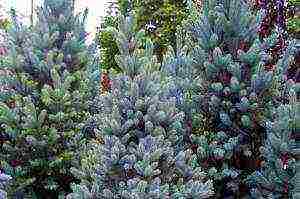 In the vastness of the former Soviet Union, the prickly spruce Picea pungens was planted in the central squares in front of the buildings of state institutions, in private plots it was a rarity. This long-lived North American plant began to be actively cultivated on our continent a little over a century ago. In nature, there are more than fifty different varieties. A beautiful plant, known to most gardeners as "blue" spruce, reaches 30 m in height, grows rather slowly, the annual growth is 5-8 cm.
In the vastness of the former Soviet Union, the prickly spruce Picea pungens was planted in the central squares in front of the buildings of state institutions, in private plots it was a rarity. This long-lived North American plant began to be actively cultivated on our continent a little over a century ago. In nature, there are more than fifty different varieties. A beautiful plant, known to most gardeners as "blue" spruce, reaches 30 m in height, grows rather slowly, the annual growth is 5-8 cm.
The needles of different tree varieties can be blue, gray-gray, silvery-green up to 4 cm long. The tree is the most prickly of the entire family of known spruce brethren. The trunk of an adult plant is powerful, straight up to 1.5 m in diameter, branches from it extend straight or rise upwards at a slight angle. The needles from the lower branches crumble with a lack of light, remain only on the branches and lateral growths of 5-6 years of age, although the plant does not lose its decorative effect.
Spruce gained popularity for its unpretentiousness and vitality in harsh urban conditions. Due to the wax coating on the needles, it perfectly tolerates the polluted air of cities and does not require additional processing for the crown.
The root system of prickly spruce is the same as that of all trees - fibrous, the suction roots are located close to the soil surface. This must be taken into account when planting a plant on the site. It will not tolerate constant cultivation of the soil near itself, and even more so under the crown.
Varieties of spruce prickly (blue)
Ornamental varieties of prickly spruce have a little more than two dozen plants, and they all enjoy constant popularity. Young plants need to be covered in winter, protecting them from freezing. In summer, young spruce trees need weekly watering in the near-trunk circle. It is also necessary to apply mineral fertilizers there, but not nitrogen fertilizers, since an excess of such dressings reduces the winter hardiness of the tree. Young plants, as well as adults, are susceptible to attack by aphids and shute fungus, which damages the needles.

Spruce prickly
Picea pungens blue diamond
- Colorado spruce "Blue Diamonds" Picea pungens "Blue Diamond" is a relatively new variety. A tree with a tall, slender trunk and a uniform conical crown grows slowly, young growth no more than 10-15 cm per year.
The needles of an extraordinary pale blue color decorate any area. The spruce does not reach large sizes (5–7 m), so it can be used as a tapeworm in mixed mixborders, as an option - as a natural barbed fence along the edges of the plot. The plant loves windless, open and sunny places, feels great on fertile and drained soils with a slightly acidic reaction, propagates by cuttings, is frost-resistant. - Spruce prickly "Waldbrun" Picea pungens "Waldbrun" is a dwarf winter-hardy variety that is great for decorating rocky gardens, mixed rockeries in contrast to other garden dwarfs and rock gardens. The tree develops into a loose ball of short thorny twigs with bright blue, gray or greenish-blue thick soft needles, grows slowly.
In an adult plant, the "ball" reaches 1 m in diameter. To increase the height of the plant, if it is necessary for the composition, the upper branches of the tree are tied up, setting the growth angle for them. The maximum height of the spruce is 80 cm. The variety does not impose special requirements on soils, does not tolerate stagnant water under the roots, therefore, when preparing the planting pit, you need to take care of good drainage. It grows in partial shade, but it is preferable to plant it in a sunny place.
In winter, to keep the plant in a healthy state, it is necessary to shake out the snow from the core of the ball so that the sun does not burn out the bark and needles of the spruce through the ice crust. The variety tolerates well the adverse effects of frost in spring and all-season polluted atmosphere. - Colorado spruce "Bialobok" Picea punges "Bialobok" - a variety of Polish selection. A low tree of two meters in height, the crown of which is formed unevenly, so there will never be two similar trees in a group planting. The trunk is often straight, solid short shoots extend from it. The plant became popular due to the unusual color of young shoots. Against the background of the main color of the needles (silver-blue), an increase with a golden-yellow color of the needles grows.
The spruce is frost-resistant, but before reaching the age of 3 years in winter, it must be sheltered from cold winds and frosts. The soils must be fertile, the spruce requires a moderately moist soil without excessive moisture. In partial shade, the plant loses its decorative effect. Since it grows slowly, it can be a great decoration for coniferous mixborders, in a flower bed with dwarf deciduous ornamental shrubs, or as a tapeworm in contrast to the overall design of the garden. Propagated by seeds that ripen at the end of the summer season, cuttings take root well. - Colorado spruce Picea pungens "IseliFastigiata" is a compact variety, which the owners of small plots like to use in their possessions. A tree with well-raised leafy branches develops into a narrow compact pyramid up to 10 m. Bright blue needles, a variety that is undemanding to the composition of the soil, is not afraid of drought, and does not tolerate excessive watering.
It looks impressive alone, but it is also actively used to form hedges. - The prickly spruce Picea pungens "Montgomery" in its "youth" has a cushion shape, which over the years changes to a wide cone up to 1.8 m. Due to its slow growth, it often adorns beautiful landscape compositions, as an accent on the contrast with ornamental shrubs, it is planted in mixborders ...
The needles are silvery-blue in young shoots and bright blue in old branches, very tough and prickly. In the shade, the spruce loses its decorative effect, does not like dense and heavy soils, one of the few representatives of the species that requires loosening in the trunk circle and sprinkling. When planting in a sunny place, you need to constantly water the plant. The crown can be formed by annual pruning, at the end of the season, removing unnecessary growth buds.
- Colorado spruce "Aurea" Picea pungens "Aurea" outwardly similar to common spruce, but is distinguished by the golden color of the needles of a young growth. The predominant shade is dark green. It stands out with a dense crown with a large number of horizontally located branches of white or light brown color. The tree is light-loving, winter-hardy, it is often used for spectacular single plantings.
- Colorado spruce Picea pungens "Koster" is an old pyramidal variety of Dutch breeding. This tree is often planted in group plantings of parks, while single plants will decorate any garden. Propagated only by grafting on the stock, it is considered an expensive variety of prickly spruce. The plant grows slowly, losing its lower branches with age, reaching a height of 10 m and a crown width of 3–4.5 m.
The branches of a young growth revive the general silvery-blue color of the needles with orange-brown spots, pleasing the eye with decorativeness. The plant requires good lighting, does not tolerate swampy and excessively moist soils, even for adult specimens, protection from the wind is necessary. Under unfavorable conditions, the trunk of the spruce bends, losing its majestic beauty. - Colorado spruce "Oldenburg" Picea pungens "Oldenburg" - a tree with a crown up to 8 m in diameter. It is a semi-dwarf form with young branches, waxy and bright orange-brown hue. Old bluish-gray needles live up to 9 years.
The plant grows rapidly, adding up to 35 cm each year when optimal growing conditions are created. Loves the sun, does not tolerate partial shade, loses its decorative effect and the strength of young growth on constantly waterlogged soils. Decently tolerates wind, despite the shallow root system. It is optimal for the urban landscape, since it tolerates pollution, moreover, it is drought-resistant, while there is no need for shelter for the winter period. Spruce is used for single plantings and in the formation of small decorative groups. - Colorado spruce "Fat Albert" Picea pungens "Fat Albert" has a wide conical dense crown with a pleasant blue color of frequently planted needles. It grows quickly enough, by the age of 10 it reaches 4 m in height. In the cultivation of this tree, it is important to maintain the leading apical shoot. It actively develops on fertile and slightly acidic soils, without stagnant moisture and in well-lit places. Winters well, in summer it requires additional watering in dry weather. Spruce is used to design park areas in group plantings, ideally fit into the landscape of small gardens.
- Colorado spruce Picea pungens "Hoopsii" is an ornamental garden variety dating back to the middle of the last century. Differs in a uniform arrangement of branches in the crown with a diameter of up to 4.5 m. The growth of young shoots from 10 to 20 cm per year ensures the impeccable beauty and density of the crown of the variety.
Young growth of bright reddish-brown shades with tough needles directed towards the end of the branch. Cones that appear already at the age of 3-4 years, with their bright crimson color, enhance the decorative effect of this variety. The maximum tree height is 12–15 m, light-loving and winter-hardy, does not tolerate waterlogging, copes well with urban gas pollution.It is used for single landings or planted with tape along the edges of the tracks.
Not all varieties of prickly spruce can be grown from seeds. Some plants are grafted and sold immediately on the trunk.
Seed propagation requires stating the achenes (preliminary germination), and then planting in wet sand with further rooting of the shoots in containers. Cutting gives the best results: the branches of plants are rooted, previously kept in special solutions for the development of the root system.
| Do you work hard in the country? Already it hurts to the point of impossibility? Especially the joints? Take a look here. Perhaps this is your salvation. | |
| Get rid of joint pain |
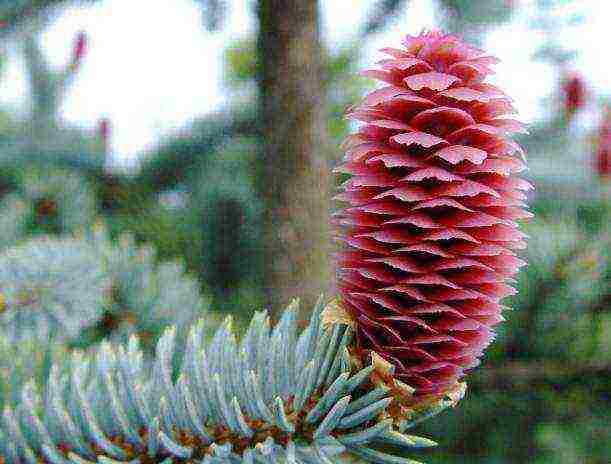
How useful was the information for you?
votes (
, rating:
out of 5)
Spruce is the "queen" of the forest, leading the popularity rating among masters of landscape art. This sacred tree, acting as a guardian of the site and a powerful source of bioenergy, is valued not only for its unique healing properties, but also for its extraordinary decorative effect.
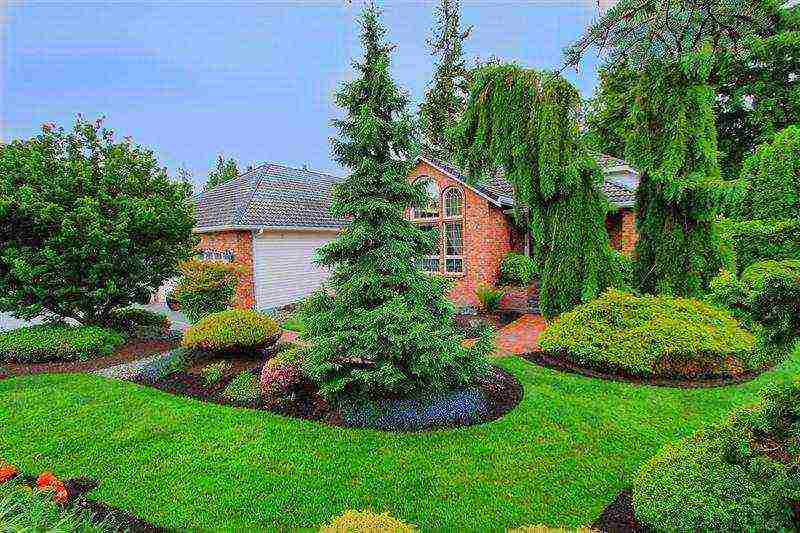
Needle foliage of emerald, dark green and even blue shades can transform plant compositions, giving a unique zest to the landscape design of the site.
Spruce applications in landscape design
Rarely can anyone remain indifferent to the luxury of color and the frozen beauty of the conifers' needles. It is not surprising that spruce is used quite often in landscaping a site. It looks great as container plantings to frame garden paths and when decorating rocky gardens.
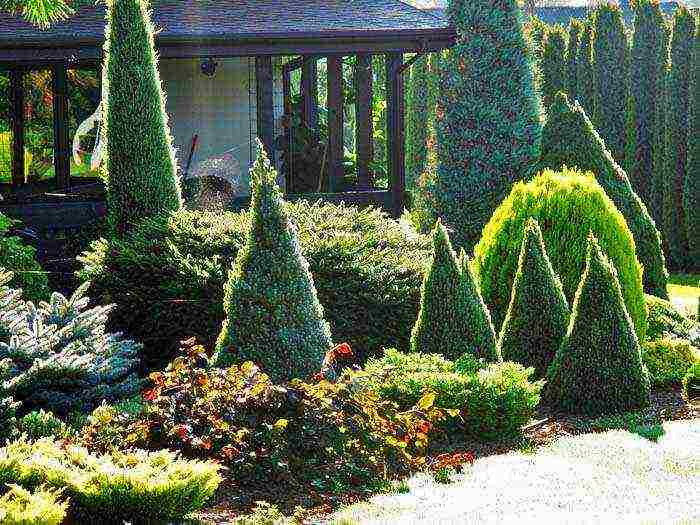
Ephedra is ideal for creating multi-level compositions, harmoniously combined with low-growing shrubs and flowering perennials.
Trees with needle-like foliage of a rich green hue look interesting in combination with bright flowers of annual and perennial plants. Perfect for creating compositions: Japanese anemones, pansies, aquilegia, phlox and hosts. Conifers are the ideal basis for creating evergreen sculptures that can make the garden look richer and more colorful.
Among the main advantages of using spruce in the design of a site, it is worth highlighting:
1. Ephedra will delight you with the saturation of shades of needle-like greenery in the summer, without fading under the sun's rays, and in the winter, contrasting with the whiteness of the snow.
2. The phytoncides secreted by the plant are capable of efficiently purifying the air, providing a healing effect on the human body.
3. Spruce is great for all landscaping styles.
4. Fluffy branches are convenient to use when making crafts: creating paintings, herbariums, New Year's compositions.
But spruce, like any other plant, has its drawbacks. For example, this ephedra is able to grow strongly, darkening the territory and depleting the soil. Therefore, for the decoration of gardens, types of spruces are used that have a dwarf shape.

Spruce is also convenient because it is easy to prune. Thanks to this, even an experienced gardener does not have any problems with giving the crown a unique shape.
It is advisable to plant spruce along the fence. In a short period of time, the ephedra grows lush forms, and its thick paws form a solid and dense wall.
Varietal variety of decorative forms
There are more than 20 types of spruce in modern parks and gardens. The main thing when choosing the type of ephedra is the configuration of its crown and the size of the plant in adulthood.
In landscape design, 3 types of fir trees are most widespread:
1. Ordinary - a typical species represented by more than 50 garden forms. Low-growing forms created on its basis reach a height of 1.2 m, and medium-sized ones - 3 or more meters. A wide palette of needles coloring, starting from golden and ending with rich green, on the branches collected in pyramidal or pillow-shaped crowns, makes this type of conifers welcome guests on garden plots.
2. Barbed - more than 70 varieties are represented in the culture.Most of them are medium and tall trees up to 40 meters high with a beautiful cone-shaped crown. Although there are also dwarf forms up to 2 m high. The needles are very prickly: hence the name of the species. It can be bluish white, steel blue, silver, and bluish green.
3. Sizaya - has more than 20 decorative forms. The species got its name due to the ash-gray color of the bark and the bluish shade of the needles. Dwarf forms of this species have a spherical and nest-shaped crown, and tall ones have a conical crown. The color palette of needles is quite wide, starting from yellowish-golden and gray-blue and ending with bright green.
Ate, like any plants, are divided into three groups: dwarf, medium and tall. When landscaping household plots, dwarf and medium-sized representatives of conifers are most popular.

Among all the variety of coniferous ornamental plants in landscape design, creeping and dwarf varieties are especially popular.
Dwarf varieties
The stunted forms include plants, the size of which in adulthood is several times smaller in comparison with the original parent species. For example, in natural conditions, the common spruce, referred to as Picea abies, is a 50-meter beauty with a neatly shaped crown, the width of which reaches 8-10 meters.
The decorative form of this tall ephedra, known as Picea abies "Nidiformis" or "pillow-shaped" spruce, reaches no more than two meters in height with a crown width of 2-3 meters.
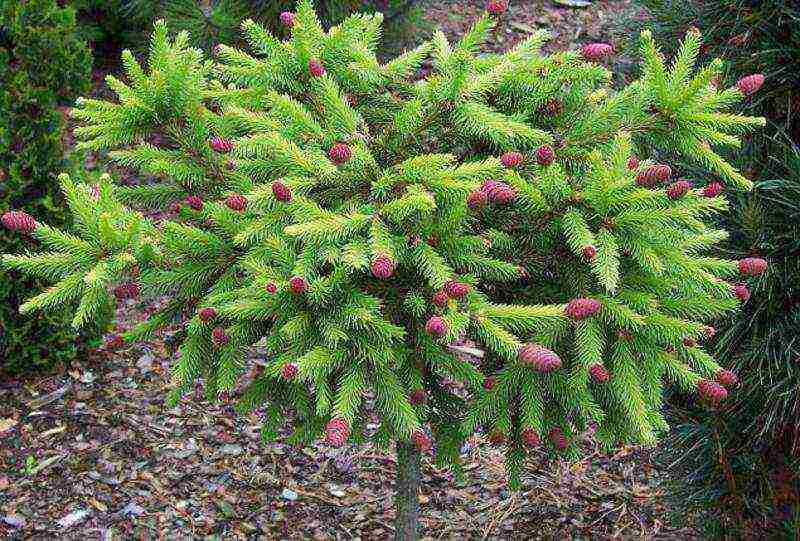
The main advantage of dwarf forms of conifers is the minimum annual growth of young shoots, which in most cases is limited to 10-15 cm.
Among modern varieties created on the basis of common spruce, conifers are famous for the greatest decorative effect, the crowns of which have a nest-like or spherical shape.
The miniature shrub Picea abies "Nidiformis" is perfect for the formation of low borders and the design of rocky gardens.
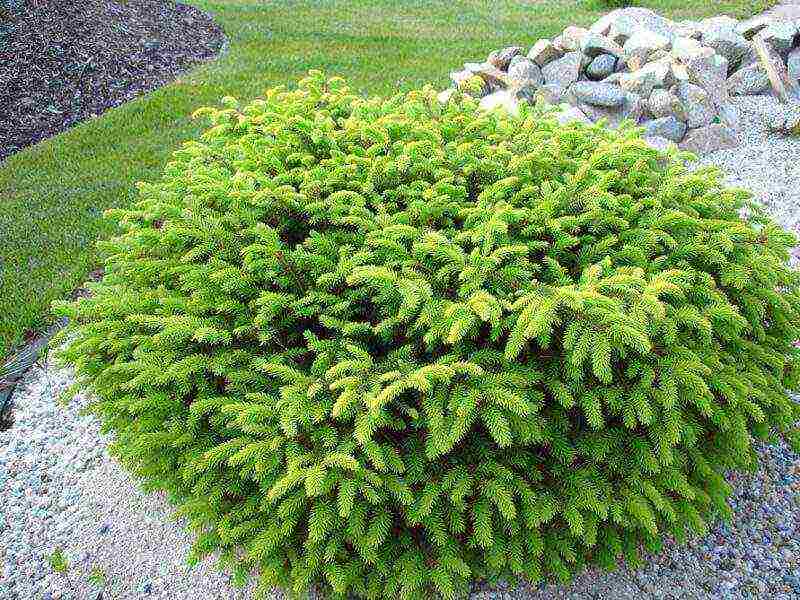
Dwarf spruce "Nidiformis" in adulthood reaches a height of only 40 cm, forming a spreading crown with a diameter of up to one meter.
The thin graceful shoots of "Nidiformis" arranged in a fan-like manner are decorated with soft and short needles of a delicate emerald shade.
Little Gemm is no less attractive. The shoots extending from the middle of the crown, framed by dark green thin needles, form a neat hemispherical "pillow". It looks especially interesting in the form of a standard form, planted in a floor container or flowerpot.
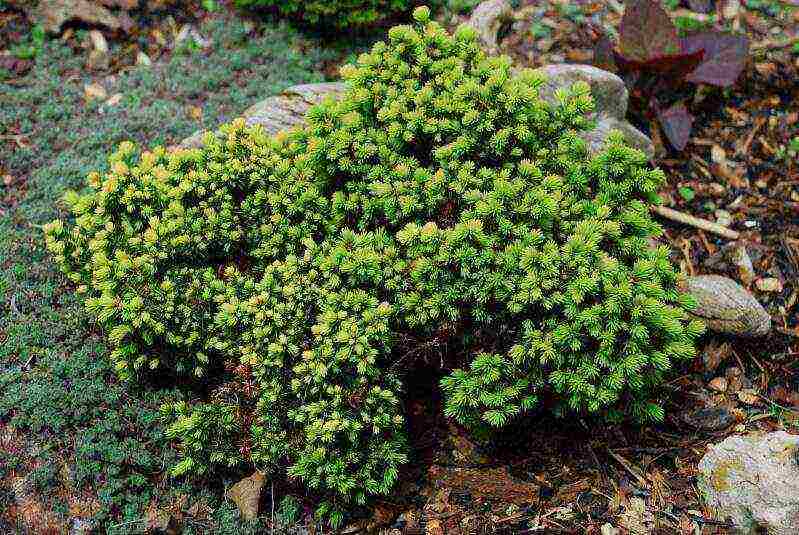
The branches of the miniature beauty Picea abies "Little Gem" are framed by soft short needles of a rich dark green hue.
Picea abies "Will's Zwerg" has a beautiful narrow conical dense crown shape. The plant is interesting due to the soft green shade of young needles covering the milk shoots, which contrasts favorably against the background of the dark green of old needles. An evergreen shrub is well suited for small backyard gardens.
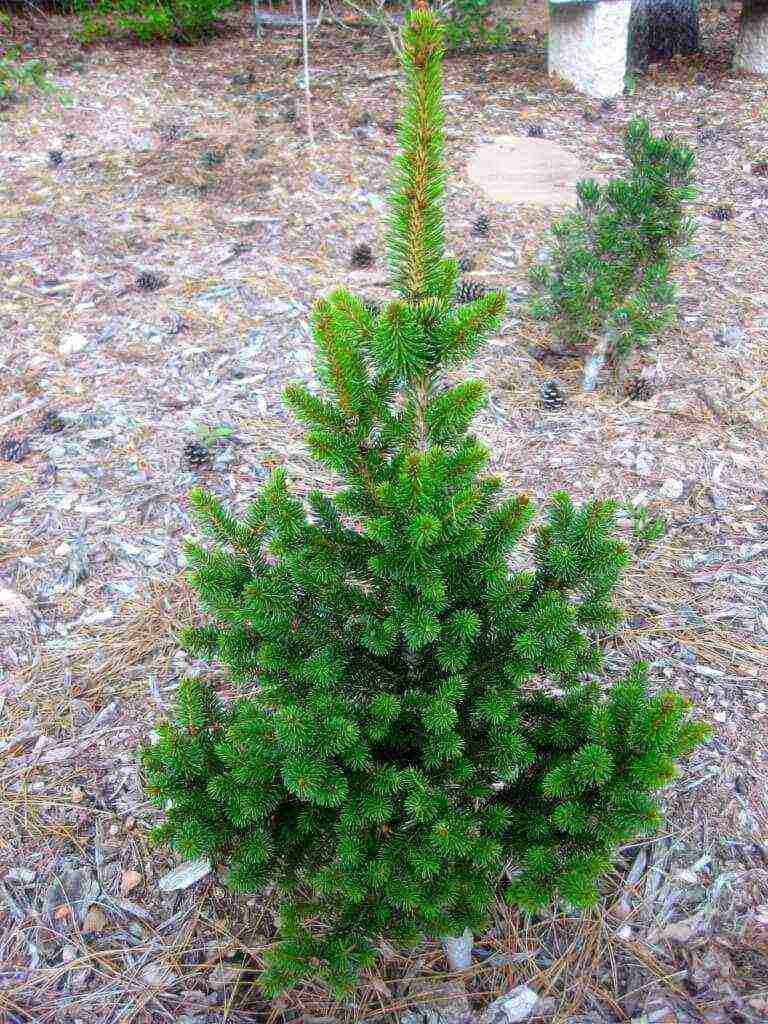
Spruce "Will's Zwerg" looks interesting in group compositions and as a tapeworm when arranging gardens with a small area.
Glauka Globoza, bred by selection, is famous for its extraordinary decorativeness. The dwarf plant does not have a clearly defined trunk. Its spreading branches, dotted with millions of fine needles in an elegant silver-blue hue, form a beautiful spherical crown. The cones that form on the branches, reminiscent of New Year's decorations, give the tree a special appeal.
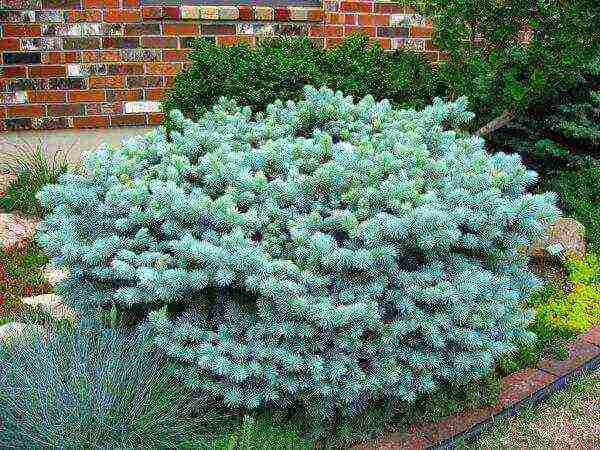
The blue beauty "Glauca Globosa" is often used to decorate city landscapes, often acting as an elegant addition to park alleys.
It is impossible to ignore the picturesquely creeping undersized varieties on the ground. The miniature "Nana" resembles a soft pillow, and the "Echiniformis" is identified with a kolobok, the round shapes of which are the original framing of garden paths.
Most types of spruce are shade-tolerant in themselves, but often their dwarf forms are very sensitive to a lack of light.
Medium-sized species
When creating a home design, it is also customary to use medium-sized conifers, the height of which reaches no more than 15 m. A small single tree with a clearly outlined crown looks picturesque against the background of a lawn "carpet" or walls of a house. A spectacular driftwood or white stone will help to complement the picture.

Spruce trees with spreading crowns are able to create a shady area for relaxation, filled with a special atmosphere of home comfort and unity with the wild nature.
Blue spruce is one of the most popular types of ephedra, revered by designers not only for its unpretentious care, but also for the mesmerizing change in shades of needle-like foliage throughout the year. Only 20% of the representatives of this species have a pronounced color of the sky, the rest are rich in green and gray tones.
Blue beauties are not able to withstand temperature fluctuations in the northern regions and feel comfortable only in temperate latitudes. Spruce with blue needles looks advantageous along the garden paths, against the background of wooden buildings or stone buildings.
A bright representative of this species is Picea pungens "Blue Diamond", which means "blue diamond".
The graceful beauty of the Blue Diamonds, with a tall, thin trunk and neatly shaped conical crown, is often used for mixed mixborders.
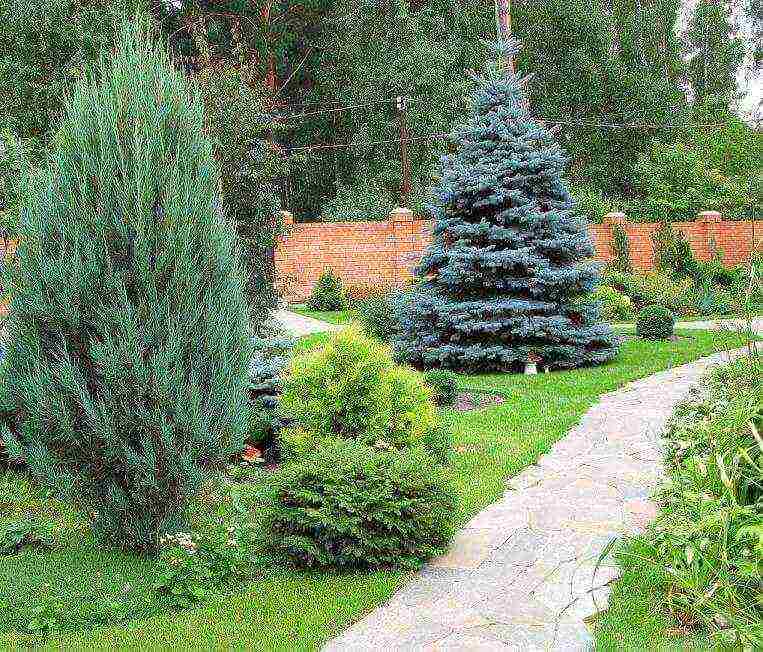 Weeping types of firs will help to diversify the collection. Given their aspiration to the aquatic environment, ephedra can be safely used when decorating the banks of reservoirs.
Weeping types of firs will help to diversify the collection. Given their aspiration to the aquatic environment, ephedra can be safely used when decorating the banks of reservoirs.
Full-size weeping spruce trees reach a height of 10-15 meters and a width of 2-3 meters. Thin branches, hanging down, bend around the curved trunk of the plant, giving it a weeping shape.
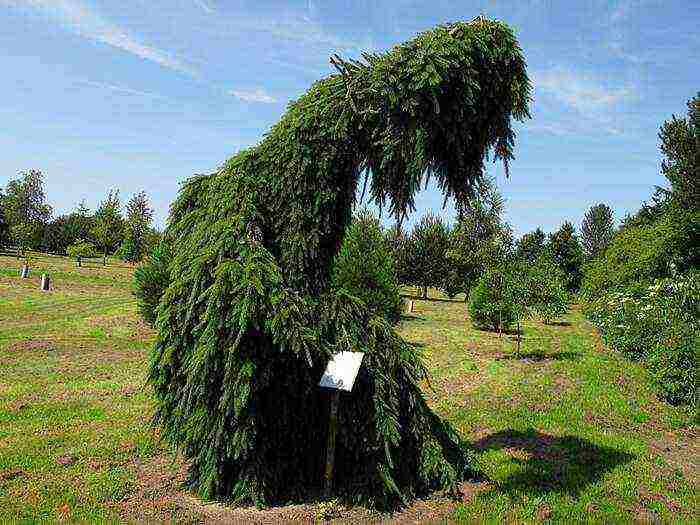
Serbian spruce "Glauka Pendula" with flexible thin shoots hanging along the trunk is a win-win option when implementing non-standard solutions in garden compositions.
The Canadian spruce is more adapted for our climate. Konika is famous for its frost resistance and unpretentious care. It is interesting for landscape design in that it has a decorative conical crown shape, gives a small increase in a year and fits harmoniously into the design of even very small areas.
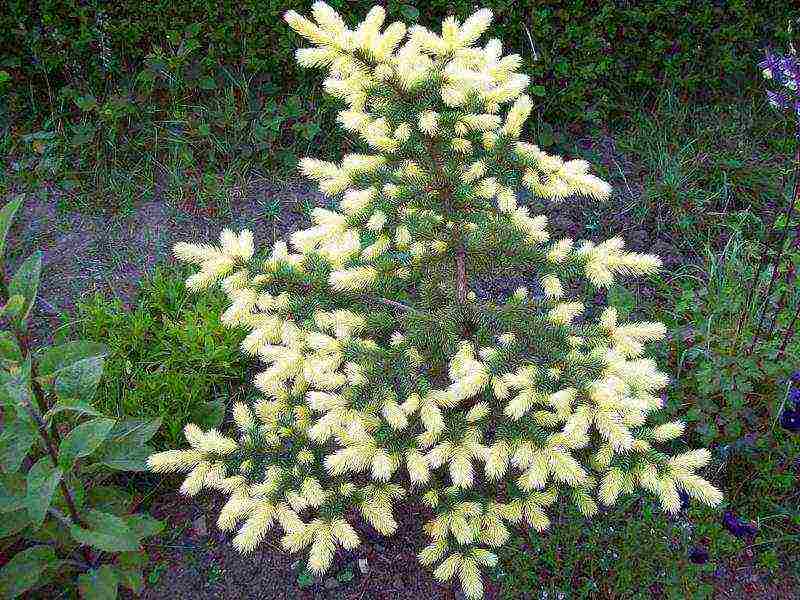
Young shoots sparkling in the sun's rays make the coniferous beauty "Maygold" look like a queen wrapped in gold.
The mantle of the crown of the tree, reaching a height of 6 m, has a loose pyramidal shape. After a few weeks, the creamy yellow needles on young shoots gradually change their color, acquiring an equally attractive bluish-green hue.
Combinations of ephedra
If the area of the site allows, then to create a picturesque and original picture, it is better to use spruce of different types and varieties.
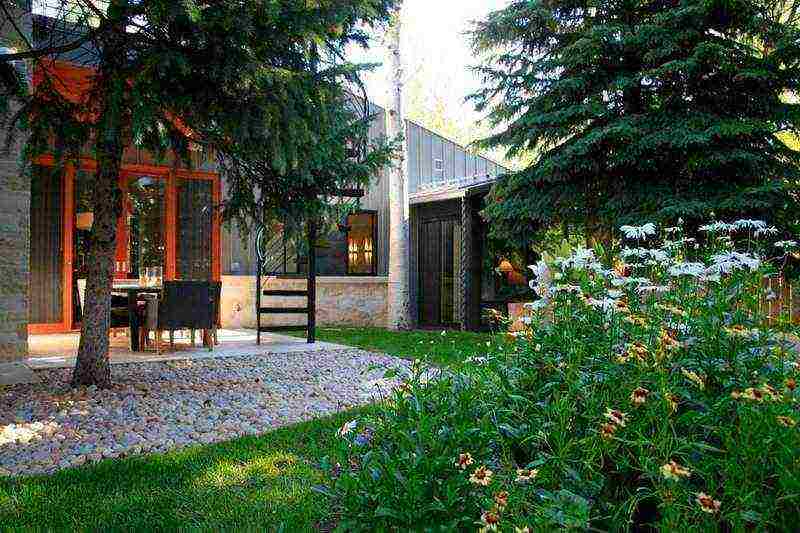
Tall trees fit well into any landscape as tapeworms, more compact forms of conifers can be safely combined with other plantings.
In order for the conceived composition to turn out to be harmonious and attractive, the masters of landscape art advise taking into account a number of main points:
- The composition should not be too colorful. For a group of three conifers, use two colors. When composing a composition of five evergreens, use only three colors.
- When composing a multi-level composition, including 20-30 plantings, place the elements in groups, matching them by color.
- The fir-tree and shrub ensemble requires a competent placement of accents: the foreground is occupied by undersized plants, the back - by medium-sized conifers.
- To avoid the feeling of the density of Christmas tree plantings, the arrangement of a regular or Moorish lawn in the near-trunk area of conifers will help.
Luscious needles of a dark shade will emphasize the beauty of the flowering shrub located nearby.In addition to flowering plants, shrubs with unusually colored foliage will be a successful addition to the coniferous beauty: weigela, chubushnik, barberry.
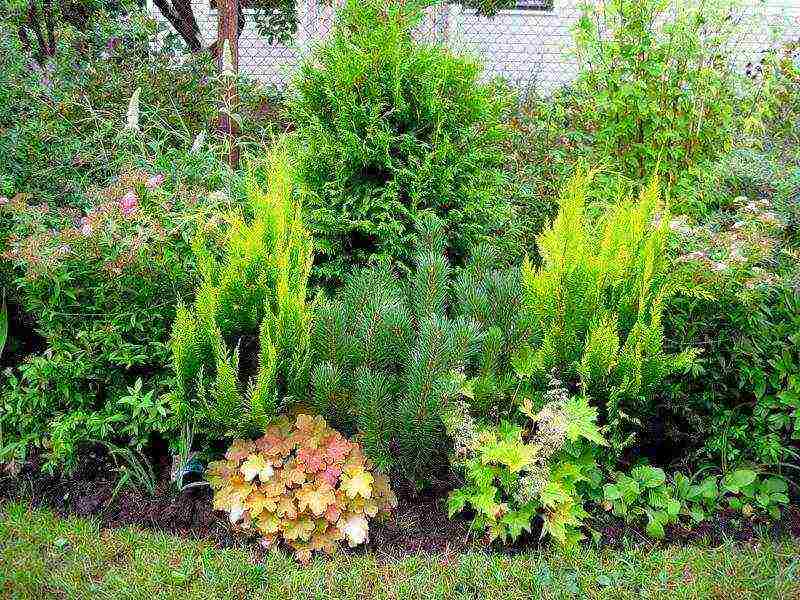
Ate is perfectly combined with other coniferous varieties and flowering perennials, creating a picturesque picture that looks elegant at any time of the year.
Recommendations for the care of spruce
Proper planting and care is a guarantee that coniferous beauties will delight with their presentable appearance almost all year round.
Wanting to decorate your site with one or more spruces, experienced gardeners advise you to adhere to certain rules:
Landing time. It is better to plant ephedra in early spring or early autumn, when the plant has not yet entered or has already passed the phase of vigorous growth. To keep young shoots from frost and rodents, it is advisable to mulch the near-trunk zone with peat for the winter.
Location... Under natural conditions, the spruce grows well near the river valley, where it receives a sufficient amount of moisture to feed its powerful root system. But at the same time, she does not like wetlands, and therefore needs a drainage arrangement.
Soil composition. All types of firs love fertile alkaline and acidic soil. They are intolerant to heavy soil types. When planting ephedra in depleted soil, the planting pit should first be enriched by adding 100 g of complex mineral fertilizer. With a lack of oxygen and nutrition, the plant may even die.
It should be borne in mind that spruce strongly affects the flowers and shrubs surrounding it, so it is better to place it at a short distance from sun-loving plants. You should not plant conifers close to each other, since with their branches they will restrict access to sunlight.
Observing these simple rules when selecting varieties and drawing up herbal compositions, you can create on your site a cozy and picturesque design that will delight the eye throughout the year.
Video instruction: we equip a hedge of fir trees
